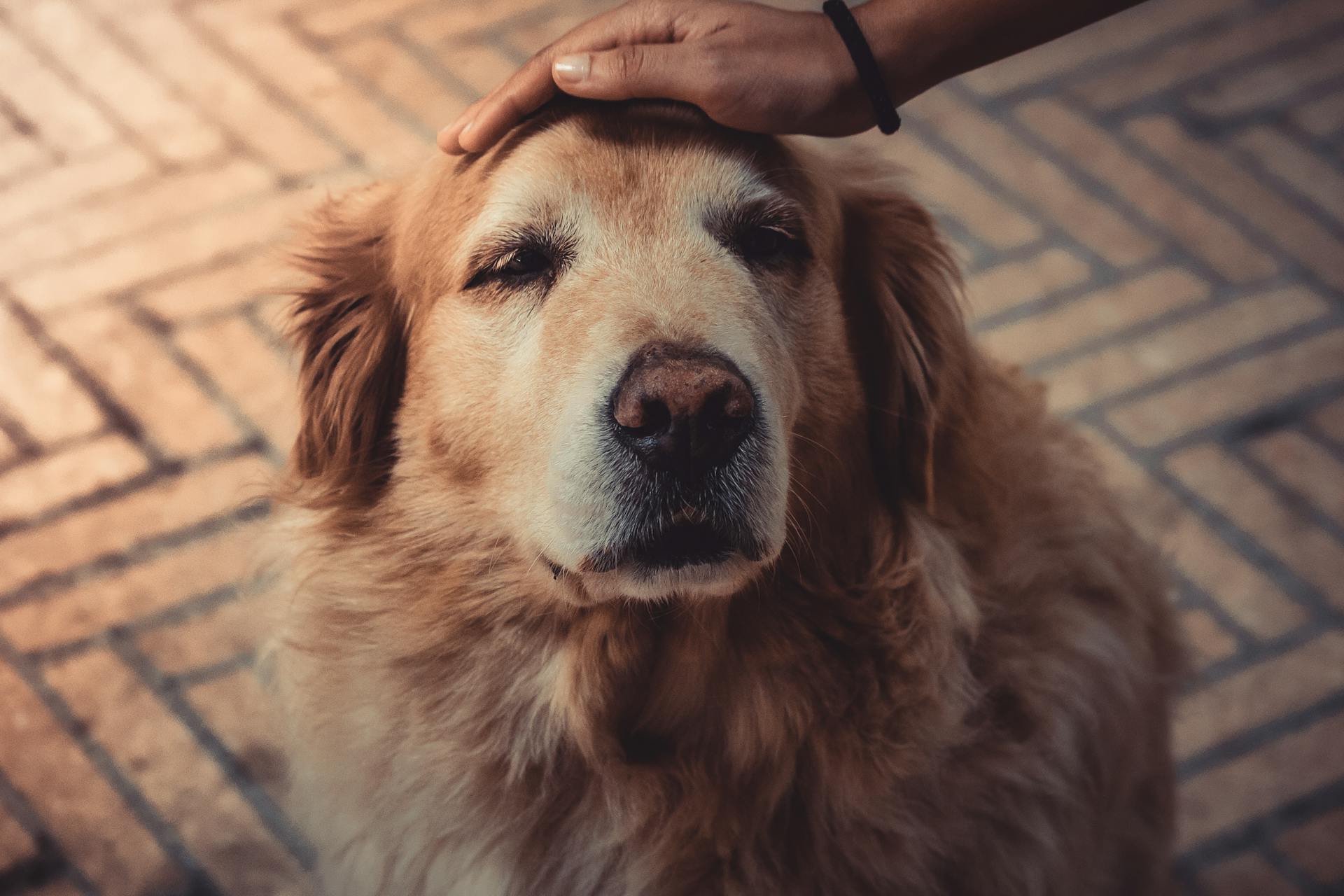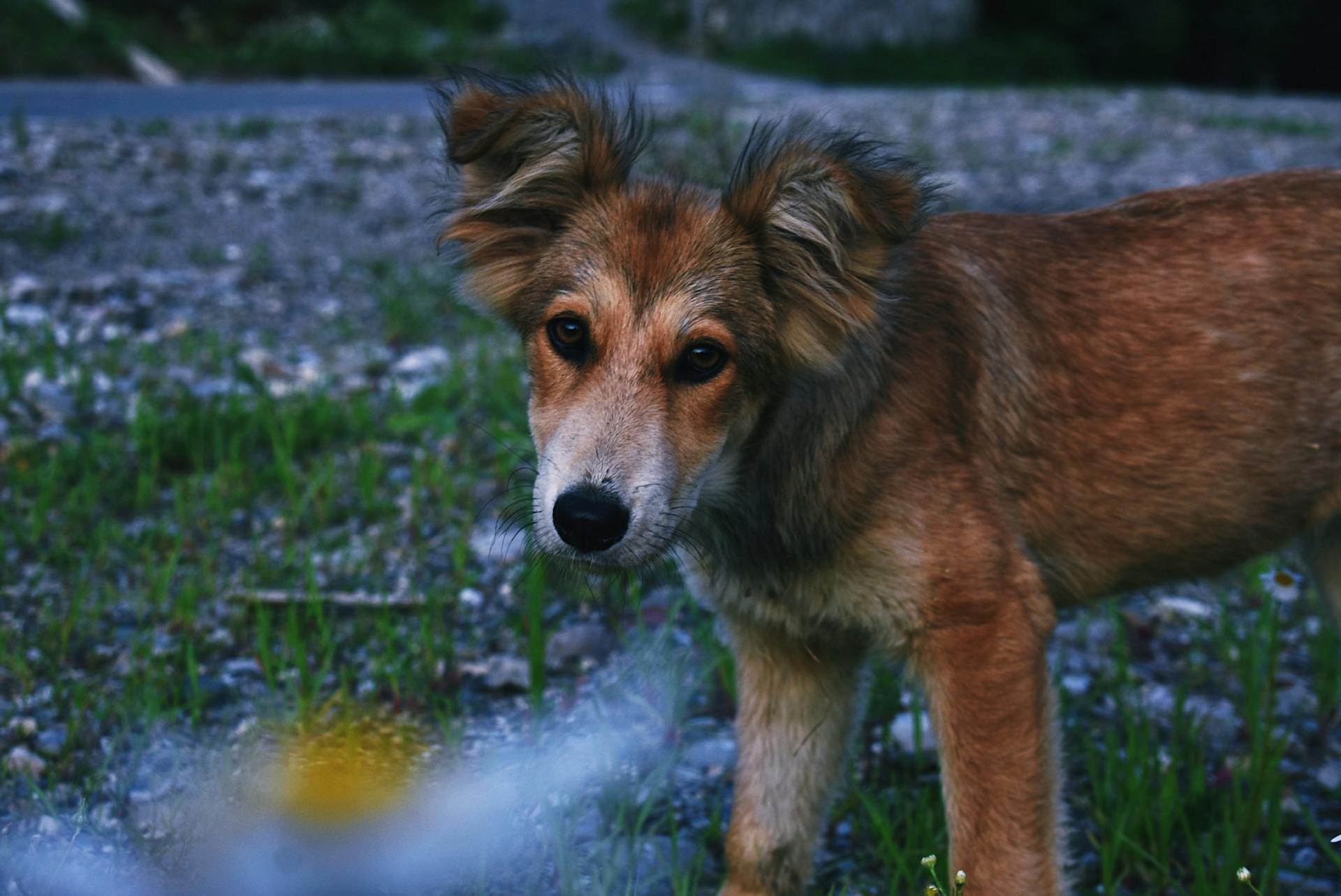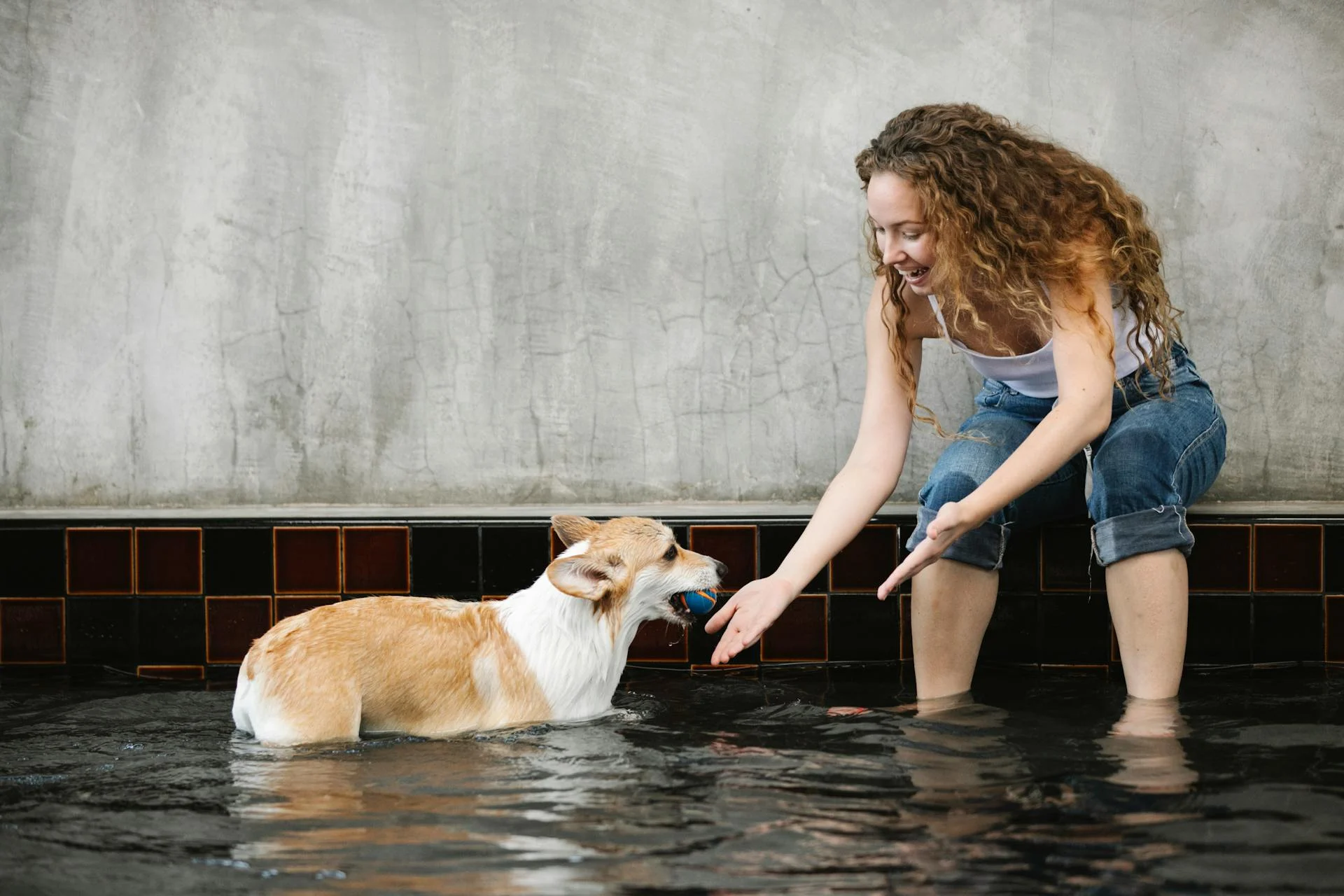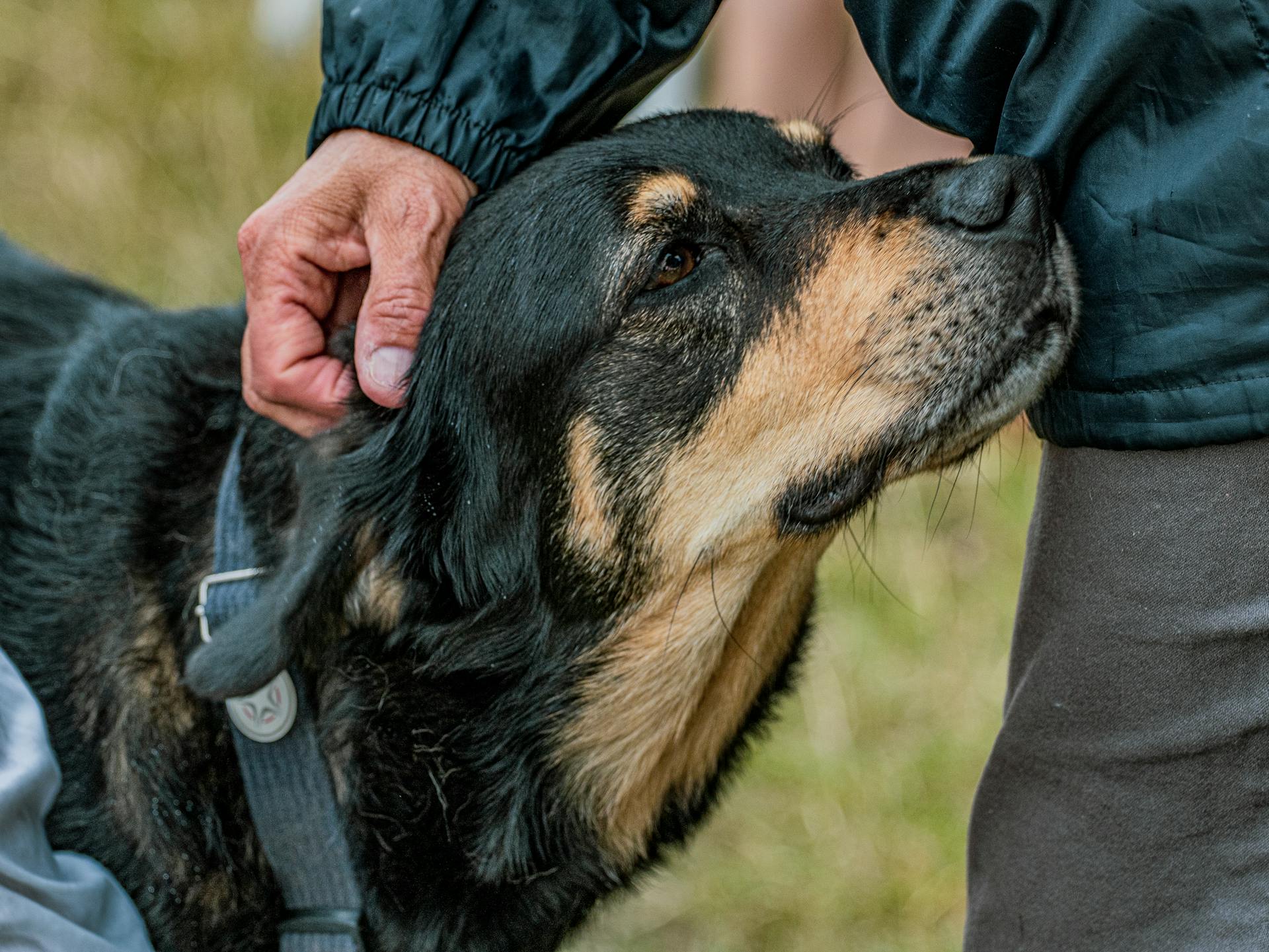
Calm dog training is all about helping your furry friend feel more relaxed and in control. According to research, dogs can pick up on their owner's stress and anxiety, making it a crucial aspect of their training.
Dogs are highly sensitive to their environment and can easily become overwhelmed by loud noises, new people, and other stimuli. This is why it's essential to create a calm and predictable environment for your dog to thrive in.
By using positive reinforcement training methods, you can help your dog associate calm behavior with rewards and praise. This approach focuses on rewarding desired behaviors rather than punishing undesired ones, leading to a more relaxed and confident dog.
A key component of calm dog training is teaching your dog to relax in the presence of triggers that might normally cause stress or anxiety. This can be achieved through gradual exposure and counterconditioning techniques.
You might like: When Do Labradors Calm down
What Defines Calmness?
Calmness can be difficult to define, because it may vary from person to person or dog to dog. It's essential to decide on what behavior you'd like to see when your dog is calm, so you'll be consistent in rewarding it and your dog will be better able to understand.
Consider reading: My Dog Bit the Amazon Delivery Person
Capturing calmness when your dog is in a down position can be helpful, as it's easy to see and dogs tend to be more relaxed naturally when they're in that position. Dogs often make a connection between relaxing and being in a down position.
The key is that your dog cannot be focused on any food or treats you have and that they are truly relaxed and calm. This is different than asking them for a stay, where they can still be over-aroused and hold a stay.
Explore further: Dog Training Position Box
Training Relaxation
Training relaxation takes patience, empathy, and persistence. Breaking it down into stages is essential to ensure your dog can succeed.
Practicing in different places can increase difficulty, so it's crucial to start in a quiet area of your home. Rewarding relaxed behaviors is a great way to begin training.
Rewarding relaxed behaviors can be as simple as dropping tiny treats to your dog as they settle down on a blanket. Gradually reward more relaxed behaviors, such as lying down or sighing.
Some dogs will take longer to relax, so it's essential to take things slowly and reward behaviors like standing quietly or disengaging from people. Make sure your dog is having a good time when settling, whether enjoying toys or simply dozing and snoozing.
Creating a calm environment is also essential for teaching relaxation techniques. Dim the lights, play soft music, or use aromatherapy with calming scents like lavender to enhance the ambiance.
Progressive muscle relaxation can help dogs release tension and promote relaxation throughout their bodies. Start with gentle strokes from head to tail, applying gentle pressure to different muscle groups.
Deep breathing exercises can help your dog calm their mind and relax their body. Sit or lie down beside your dog and take slow, deep breaths, encouraging them to match their breath with yours.
Teaching a default behavior, like lying down calmly, can be a great way to have your dog stay calm in public or at home. Start by having your dog on a leash and sitting down, waiting for them to lie down on their own.
A different take: Aggression after Neutering Dog
Basic Obedience Training
To start basic obedience training, focus on teaching your dog to sit and stay on command, with short durations that gradually increase as they become more comfortable.
Practice loose leash walking to ensure your dog walks calmly and politely beside you, preventing them from pulling or lunging towards stimuli in public.
Teach your dog to focus and leave it commands, which help them maintain their attention on you amidst distractions and redirect their attention away from potentially harmful or tempting objects.
By establishing a solid foundation in basic obedience training, you'll be well on your way to raising a calm and well-behaved dog.
Curious to learn more? Check out: Dog Training Focus Exercises
Understanding the Importance of Training Your Dog
Training your dog is essential for building a strong bond between you and your pet. It's also crucial for their physical and emotional well-being.
Housebreaking, for example, is a fundamental aspect of dog training that helps prevent accidents and saves you from the hassle of cleaning up after your dog. By establishing a routine and sticking to it, you can teach your dog to go potty outside where they belong.
Dogs that receive proper training are less likely to develop behavioral problems such as barking, chewing, and digging. These issues can be avoided by teaching your dog basic obedience commands like "sit", "stay", and "come."
Consistency is key when it comes to training your dog. By using positive reinforcement techniques and rewarding good behavior, you can help your dog learn quickly and efficiently.
Level 1: Get the Behavior
To get your dog to lie down on command, start by placing a mat of your choice down in a quiet area and using a food lure to encourage them to lie down on it. Reward them heavily with treats as soon as they do this.
Use a calm and steady stream of treats between their paws, delivering one every 1-5 seconds, for about 1-2 minutes. This will help them associate the mat with a positive experience. Give your release cue, "ok", and toss a treat away to let them know the game is over.
Pick up the mat when not in use and practice this step 5-10 times in different parts of the house until your dog automatically lays down when the mat comes out. This will help them learn to associate the mat with the desired behavior.
On a similar theme: Dog Training Grass Mat
Managing Stress and Anxiety
Creating a safe space at home is essential for dogs who experience stress and anxiety in public settings. Designate a quiet area with comfortable bedding, puzzle toys, and calming music to help your dog feel secure.
Gradual exposure to public environments is a key strategy for building confidence. Start with low-stress situations and gradually increase the level of exposure, allowing your dog to adapt at their own pace.
Rewarding calm behaviors is a powerful way to counter-condition your dog to public spaces. Use positive reinforcement techniques to associate public areas with positive experiences, such as treats and praise.
Calming supplements can provide additional support during the training process. Consult your veterinarian about the possibility of using natural calming supplements or medications to help reduce your dog's stress and anxiety.
Managing stress and anxiety is a gradual process that requires patience and consistency. Celebrate small victories along the way, and don't hesitate to seek professional help if your dog's stress and anxiety persist or worsen.
Readers also liked: Calming Food for Dogs
Training Techniques
Start with basic obedience training to provide your dog with the necessary skills and discipline to navigate different situations calmly. Focus on teaching your dog to sit and stay on command, as well as loose leash walking.
Teaching relaxation techniques can also help your dog remain calm in public. This can be achieved by creating a calm environment, such as a quiet area in your home with soft music or aromatherapy.
To capture calmness, observe and reward your dog's calm behaviors voluntarily, without asking for them. This can be as simple as rewarding your dog for settling down on a blanket or lying down quietly.
Explore further: How to Calm Dog Aggression
Capturing Data
Capturing data is a crucial part of training, and it's not just about observing your dog's behavior, but also about rewarding the good stuff.
Calmness is a great place to start, and it's essential to capture this behavior because it's not natural for all dogs. Calmness is beneficial for all dogs, though, and we can help them find a state of calm relaxation by rewarding the calm behavior.
You might like: It's Your Choice Dog Training
One way to capture calmness is to catch your dog relaxing and being calm, and then reward this behavior with treats. This can be as simple as placing a treat on the floor between their paws when they're in a calm state.
Initially, your dog may get up and follow you, but it's essential to ignore them and go about your day. This helps them learn that the calm behavior is what gets rewarded, not the excitement of following you.
By consistently rewarding calm behavior, you can help your dog enjoy being calmer, and eventually, they'll begin to associate calmness with positive outcomes.
On a similar theme: When Do Dachshunds Calm down
Teaching Default Behavior
Capturing calmness is a great way to teach your dog to relax, but it's not the same as teaching them to have calmness as a default behavior. This is where teaching a default behavior comes in, which is what your dog will do when you're not focused on them and they're on a leash.
A unique perspective: How to Teach a Dog Obedience
To teach a default behavior, start in your home with no distractions, with your dog on a leash and some treats ready to go. Put your dog on a leash and go sit down, keeping the leash short enough that they can't get into anything, but long enough so they can choose to lie down.
Your goal is to have your dog lie down on their own, and when they do, place a few treats on the floor between their paws. If they get up, the treats stop until they lie down again. This will help your dog understand that lying down is a calm behavior.
It's essential to wait until your dog is actually calm and relaxed, not just lying down. If they lie down and stare at you, expecting a treat, you're not rewarding calmness, but focus instead.
Once your dog can comfortably and reliably relax inside the house, move it outside to the yard, then maybe try a quiet park setting. Slowly increase the distractions for your dog until they're ready to relax on a cafe patio with you. This may be a quick process for some dogs, and much longer for others, so don't rush it and allow your dog to set the pace.
Remember, the goal is to have your dog learn to relax and be calm in different situations, not just when they're in a quiet room. With patience and consistency, you can teach your dog to have calmness as a default behavior.
Expand your knowledge: Are German Shepherds Clingy
Socialization and Exposure
Socialization and exposure are key to calm dog training. Gradually exposing your dog to different environments helps them become familiar with various sights, sounds, and smells.
Start with quieter and less crowded areas, like parks or cafes, to allow your dog to observe and experience new things while feeling safe and secure. Controlled socialization is essential for a positive experience.
Reward your dog with treats, praise, and affection whenever they exhibit calm behavior in public. Positive reinforcement helps them associate public environments with positive experiences and encourages them to remain calm.
Desensitization techniques can be used if your dog shows signs of anxiety or nervousness in public. Gradually expose them to the stimuli that trigger their anxiety, using positive reinforcement to create positive associations and reduce their sensitivity.
Exposing your dog to new people and animals in controlled settings is crucial for building their confidence and reducing the likelihood of anxiety or aggressive behavior.
A fresh viewpoint: Dog Training Positive Reinforcement
Conclusion and Future
Training your dog to be calm in public is a rewarding and essential process that enhances your bond and allows for enjoyable experiences together.
By following the outlined steps, you can help your dog develop the necessary skills to navigate public spaces with confidence and composure.
Remember, patience and consistency are key to successful calm dog training.
A Happy Future
A Happy Future is within reach for you and your dog. With the right combination of exercise, training, and management, you can help your dog chill out and find their forever home.
Exercise is a crucial component of this combination, and it's not just about burning off energy. Squid, the dog in the article, is a great example of how exercise can help calm a hyperactive dog.
Training is also essential, and it's not just about obedience commands. A qualified behavior professional, such as Pat Miller, can help you develop a training plan tailored to your dog's needs.
Management is just as important as exercise and training. It's about creating a routine and environment that promotes calm behavior in your dog.
With the right combination of exercise, training, and management, you can ensure your dog's calm and happy future in your family.
Explore further: Do Rottweilers Growl When Happy
Conclusion

Training your dog to be calm in public is a rewarding and essential process that enhances your bond and allows for enjoyable experiences together.
The key to success lies in following the outlined steps and incorporating positive reinforcement techniques, just like the experts at the Calm Canine Academy recommend.
By teaching your dog to relax on cue, you'll be able to navigate public spaces with confidence and composure, just like you want.
The Calm Canine Academy values teaching calm behaviors so highly that they named their company after it - a testament to the importance of this skill.
If you're interested in learning more about relaxation training, you can check out their signature Calm Canine Masterclass for further guidance and support.
Readers also liked: Top Dog Training Academy
Sources
- https://www.calmcanineacademy.com/blog/2020/06/22/relaxation-training
- https://milwaukeepaws.com/how-to-capture-calmness/
- https://www.whole-dog-journal.com/behavior/training-a-hyperactive-dog-to-calm-down/
- https://www.dogstrust.org.uk/dog-advice/training/basics/settle-training
- https://blog.tryfi.com/train-your-dog-to-be-calm-in-public/
Featured Images: pexels.com


